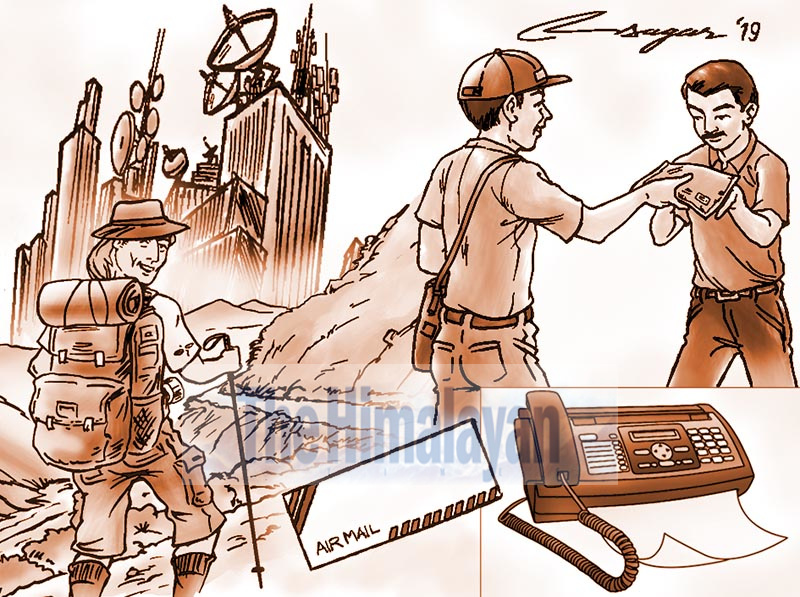Travel industry: Harbinger of technology
It was not surprising that the cheapest medium of communication was by mail through the postal service. There were ordinary mail, airmail and registered mail. There were no couriers then. So a company sent documents through the post office
The travel industry ushered in modern communication technology in the country. Starting with a humble typewriter, today we use conspicuous world-class technology for all our communication needs.
A spurt in tourist arrivals in the early days of the tourist flashflood spawned demand for workers with the ability to communicate in the English language for various tasks. English-proficient workers were required to take care of clerical work behind the curtains and to chaperone travellers outdoors on tours, treks and rafting. Apart from English, another qualification needed for office tasks was the skill to work on a typewriter, much like a computer today. So, English and typing skills were the two main criterions that could win anybody a job in an office without any recommendations or push whatsoever from any power, royal, political or personal.
If someone came with additional skills in the art of using communication equipment of the day, such as cable, telex and cyclostyle, they could earn more. Cable, or telegram, and telex were like today’s faxes and email, respectively, the fastest means of communication with the outside world other than the telephone. The post office handled the cables. While cables took a few days to reach, telex delivered message much faster, almost instantly, within a day by the latest. But telex was also far more expensive as it used the telephone for connection. Nepal Telecom processed all telex communications, meaning they would make connections between two parties.
It was not surprising that the cheapest medium of communication was by mail through the postal service. There were ordinary mail, airmail and registered mail. There were no couriers then. So how did a company send documents? Mostly, through the post office.
Also, the elite of the day would use their public relations with the airline crew to send their documents to Delhi for collection from their office. Luckily, 99 per cent of the tourism business came through the Indian agents. Some big companies would even have their staff fly to Delhi to hand-carry documents. Later, pashmina traders emulated this method and started hiring ‘couriers’ to hand-deliver raw materials in Delhi. The couriers would charge hefty fees. Once the courier companies opened their shops, these personal initiatives became part of rich travel history.
Cables were much simpler to use. The communication text would look somewhat like the SMS today that would be handwritten or typed in abbreviated words on prescribed forms, available at the post office. The charges were expensive for the day. Thus proper knowledge in writing messages in acronyms or abbreviated forms was essential not only to convey the message accurately but also to save money. Therefore, mastery of the English language was imperative.
A telex was an intimidating machine. Before fax and email came into the world, it was the most reliable, secure and fastest means of communication, business or otherwise. It operated automatically over a telephone connection, with a continuous clattering sound. For sending a message, it had to be typed on to a strip of paper, mounted on the side of the machine. The typing would make perforations or encryptions on the paper strip. The travel business could not run without this indispensable communication machine. But not everyone could afford it. With charges per minute, it was expensive to communicate through a telex machine.
What would you do if you wanted a copy or copies of the same document? Nepal did not have the luxury of the photocopy machine. They came much later. So the easiest thing to do this was to put several papers in the typewriter with carbon papers between two sheets to produce multiple copies. You then typed the whole content as it appears in the original document, word by word, including the name of the company, address and the name of the signatory under the heading “True copy”. Once attested by a competent authority, it becomes a valid document.
But what do you do when you require multiple copies of the same document. In the travel business, you need to print an individual copy of an itinerary for all the tour members, sometimes numbering nearly 70 or 80 people. You either have to type them repeatedly with as many carbons as a typewriter can hold, or do so at one go with the help of a cyclostyle machine. A cyclostyle was a daunting machine, a far more intricate and cumbersome version of the photocopy machine.
How did it work, though? Well, first you had to type the text on a special paper that came with three sheets, two cover and one inner page. You etched the letters by typing hard on the 3-sheet paper. The etched paper is then rolled around a small removable cylindrical drum, coated with a black and pungent chemical solution. It was quite a task producing multiple copies by using the cyclostyle machine.
Many years later, some enterprising Japanese brought the first known photocopy machines. But in the early days, the machines were expensive. So was the photocopy, at almost a hundred rupees per copy. But despite the high costs, these made life easier, especially for the travel staff, who were among the first to use new communication and office support technology, including the fax, email, mobile and internet.






